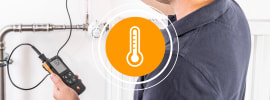
Introductory text
Several hundred million people all over the world work in offices. Many of them are dissatisfied with the ambient conditions where they work. The most common reasons are complaints about thermal comfort and indoor air quality.
The complaints usually need to be investigated by a measuring technology technician. This person is faced with the challenge of objectively evaluating employees' thermal sensations in order to determine whether the complaints are justified and, where applicable, pinpoint their causes and eliminate them. From a business perspective alone, it goes without saying that the complaints need to be taken seriously since employee performance directly relates to the ambient conditions in the workplace.
The aim of this practical guide is to offer support to those responsible for indoor climate and to identify ways of objectively evaluating subjective impressions about the level of comfort.

What is thermal comfort level?
Thermal comfort plays a decisive role in physical and mental capabilities.
The human body's sensitivity to heat essentially depends on the body's thermal equilibrium (thermal balance). This thermal equilibrium is affected by physical activity and clothing as well as ambient atmospheric parameters. These are:
Air temperature
Radiation temperature
Air velocity (draught)
Air humidity
Thermal comfort occurs when a person feels thermally neutral. This happens when someone finds the climatic parameters (temperature, humidity, draught and thermal radiation) in his surroundings pleasant. There is no requirement for warmer or colder, dryer or more humid ambient air. Thermal comfort also depends on the person's type of activity and clothing.

That was only a small excerpt. Would you like to find out more?
Practical guide contents
1. Introductory text
2. What is thermal comfort level?
3. Reasons for using measuring technology for thermal evaluation in the workplace
4. Measures taken by the air measurement technician in the event of a complaint
4.1. Preparation
4.2. Measurement of room air temperature and humidity
4.3. PMV/PPD measurement
4.4. Measurement of turbulence and draught
4.5. Other criteria for evaluating the comfort level
4.6. Evaluating the indoor air quality
5. Conclusion

























